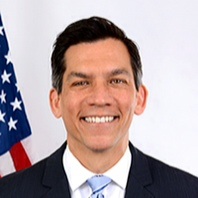
Exclusive
How data is making your building, office space better
Norm Dong, who spent three years as the commissioner of Public Buildings Service at GSA before leaving last month, said through a portfolio management process the...
The Public Building Service at the General Services Administration knows more about the status and health of federal buildings than ever before.
But managing federal real property is more than just having a higher quality of data.
Norm Dong, who spent three years as the commissioner of PBS and now is a senior adviser at the Federal City Council, said GSA is using the improved data quality to better meet agency customer office space and facility needs.
“We’ve been undertaking a much more meaningful portfolio management process that really looks at our assets and recognizes we will never have the dollars that we need to maintain all of the assets that are currently in the portfolio,” Dong said in an exclusive exit interview before he left in March 30. “This really forces us to make some really tough decisions, but smart decisions in terms of which assets are we going to keep and reinvest for the long term versus those other assets that are underutilized and quite frankly have a more productive use outside of the federal government.”
It’s this type of analysis that has led GSA to reduce the amount of office space it leases for agencies, to help agencies spend less on rent and get rid of underutilized properties.
Dong said over the last three years there has been a focused effort to move these properties off the federal books. For example, under the administration of President Barack Obama, the Office of Management and Budget and GSA led the “Reduce the Footprint” and “Freeze the Footprint” initiatives resulting in a reduction of 24.7 million square feet from the inventory between 2013 and 2015, saving the government about $300 million in rent, operations and maintenance costs.
Agencies have made less progress in reducing leased space. The Government Accountability Office reported in February as part of its annual High Risk List that GSA’s progress has been modest in reducing leased space. GAO said GSA reported that the amount of space it leases fell for three straight years, but totals only a 4 percent drop since 2013.
Dong said the topline numbers don’t necessarily tell the entire story about the progress of helping agencies move dollars away from excess real estate and to mission areas.
IRS, FEMA reduce office space
“If you look at the consolidation projects where we helped agencies reduce their footprints and also move from expensive leases to federally-owned space, we will be saving taxpayers $76 million each year based on the projects that already have been funded,” he said. “And it goes beyond the size of the footprint, it really goes to the quality of the space as well. We are trying to create more modern work environments that reflect an efficient use of space but also allows for the collaboration that is required and that we think is so critically important within agencies and among agencies.”
GSA highlighted the IRS’ Atlanta, Georgia office that reduced both its square footage by approximately 41,581 square feet and annual rent by approximately $852,000 a year. The office’s utilization rate went from 195 square feet per person to 144.
“In many of these instances, you are seeing agencies that had had multiple locations consolidate into fewer locations. The example that I like to use is the example of my former agency of FEMA where at one point, not too long ago, they had 11 locations in the National Capital Region and they’ve consolidated to far fewer and are saving millions of dollars each year in rent,” Dong said. “We will always have a significant amount of leasing transactions to support the housing needs of our agency tenants. That being said, we recognize we have federal buildings that aren’t always fully utilized. When we get an agency space requirement, we look at that requirements and ask the question, ‘are we able to meet that space requirement using underutilized federal space before we go out to the private market to seek a commercial lease?’”
He said the judiciary branch would cut the amount of real estate by 3 percent by 2018, and GSA is building nine new courthouses across the country.
GSA pointed to two examples of progress, including the U.S. Bankruptcy court in San Francisco, California, which moved from a lease in the financial district to the Burton Federal Building and U.S. Courthouse in December 2015. The agency says the court reduced its space by almost 27,000 square feet and now is seeing an annual rent savings of almost $1.5 million.
Additionally, a probation office in Chicago, Illinois, reduced its space requirement from 53,000 square feet of leased space to 20,000 square feet of owned space. GSA says this one project reflects a footprint reduction of 55 percent, and annual rent savings of $1.4 million.
Part of the way GSA is able to manage these spaces and achieve savings, Dong said, is the maturation of the real property management and asset consolidation tool.
He said through the tools and data, GSA and agencies can look at each of their assets to make better decisions about keeping or getting rid of them.
And there is quite a bit of work to be done. GAO also found that according to GSA’s Federal Real Property Profile (FRPP) database, in 2015, 23 agencies reported more than 7,000 excess or underutilized properties.
$750 million for Volpe complex
Dong said one example of GSA’s progress in getting rid of underutilized buildings is the recent Cotton Annex in Washington, D.C. He said GSA closed on the sale of the Annex in April after it had been vacant since 2007.
“One of the things I’m most proud of is the exchange we recently completed with Massachusetts Institute of Technology (MIT) on the Volpe complex, and that’s a deal that is going to be worth about $750 million for the federal government,” he said.
Under the agreement, GSA, Transportation Department and MIT agreed to construction of a new Volpe facility on a portion of the property in Kendall Square that will be retained by the federal government, and allows MIT to redevelop the remainder of Volpe’s 14-acre campus.
Federal Property News
Some of GSA’s other attempts to be creative haven’t worked out yet. The FBI building exchange remains up in the air, and GSA recently changed its plans to exchange the Labor Department headquarters building for another site in the metro area.
Dong said one of the biggest changes over the last few years is the recognition that each agency’s office space needs are somewhat different. Back in 2013, GSA envisioned significant reductions in the amount of square feet per employees as a way toward consolidation and money savings.
Dong said GSA has come to realize over the last few years that a “one size-fits-all” approach doesn’t necessarily work governmentwide.
“We really recognize that agency mission dictates different space requirements and facilities needs and we want to be sensitive to that. That’s why we thought it was really important for the agencies to define their own space utilization standard as opposed to have it dictated from a higher level,” he said. “There is a widespread recognition that it’s not so much about the size of the footprint, but it really is about the quality of the space. When we think about the more modernized work environments that we are seeing today, we are seeing a lot more amenities that take the form of more common space that aren’t so focused on what an individual gets in terms of his or her office, but it really is about the overall quality of the work environment.”
Changes needed to Federal Building Fund
Dong said he decided to leave PBS now for two main reasons. The first is the opportunity once again to work at the Federal City Council with former D.C. Mayor Anthony Williams. Dong served as deputy mayor under Williams in the late 1990s.
Secondly, Dong said he believes it’s important for the Trump administration to establish their own team with their own priorities.
Dong said GSA still needs congressional help with making the disposal of real property easier as well as letting the agency keep a higher percentage of the rent it collects from customer agencies to be used for renovations and upkeep.
“What we’ve seen recently is GSA doesn’t always have access to all of the dollars we collect from our federal tenants and as a result that has taken a toll on the quality of the federal buildings and what we are able to do in terms of repairs and alterations,” he said. “We’ve got such a significant backlog of need across our federal portfolio, whether we are talking about courthouses or land ports of entry or other federal facilities and it’s important for us to address those needs because it does affect how our tenant agencies are able to execute our mission.”
Copyright © 2025 Federal News Network. All rights reserved. This website is not intended for users located within the European Economic Area.
Jason Miller is executive editor of Federal News Network and directs news coverage on the people, policy and programs of the federal government.
Follow @jmillerWFED
Related Stories

Federal real property portfolio could be ripe for picking under Trump administration

Reliability of data, over-reliance on leasing, keep federal real property management on High-Risk List

GSA’s buildings exchange projects need more risk planning, revised reports, funding requirements




